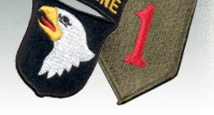Omaha Beach, H-hour+3minutes
146th and 299th ECB Assault teams
The 146ECB and 299ECB demolitioneers had the mission of
hand-placing explosives on the anti-landing-craft beach obstacles,
so as to clear sixteen 50-yard gaps for the following infantry landing
craft. Each forty-three man demolition team came ashore with
almost a ton of C-2 plastic and tetrytol explosives.
Sixteen primary Gap Assault Teams landing at H + 3minutes; were
to be followed by 8 support teams that were to land immediately
thereafter where needed, as directed by the sector commander.
The 146ECB had the responsibility of the western beach sector
that stretched from Dog Green at Vierville Draw (D-3), through
Dog White, Dog Red, to Easy Green near les Moulins Draw (D-3).
The 299ECB had a similar mission on the eastern sector which
included subsectors Easy Red and Fox Green.
The demolition was intially planned to be done in-the-water by
21 NCDUs--(Naval Combat Demolition Units), augmented with
five combat engineers per team about March 1944. When the
obstacles began showing in ever greater numbers, it became
obvious to the planners that additional demolition personnel
were necessary.
It was then that the 146ECB and 299ECB were brought in
and trained by the NCDUs. When the training was
completed, the engineer augmented NCDU teams were
attached to the larger army teams, whose officers then
became the commanders of the combined teams. This
was done because the demolition now became an army
mission--to be done on dry sand as opposed as to the
in-the-water demolition as originally envisioned. About
150 men from the 2nd Infantry Division were brought in to
add to our teams.
Total navy demolition personnel--183
Total army demolition personnel--773
Upon arriving on Omaha, Gap Assault Team #8
immediately ran a ring main of primacord around the
50 yard wide group of wooden obstacles and blew
them away. We then moved inland and attached
15lb Tetrytol satchel charges to the heavy steel
"hedgehogs". Before we could destroy them, the
second wave of infantry landed nearby, and we were
forced to delay the demolition in order to keep from
making mincemeat out of our infantry. The fast
moving incoming tide soon covered the hedgehogs,
and they were not cleared until after noon on the
outgoing tide.
There were almost 100 fatalities among the engineers,
and the NCDUs must have suffered similarly, but I have
no accurate records of the navy killed. Although my Gap
Team suffered only 3 army fatalities among the 31 total,
about two-thirds of the rest were wounded--many not
severely.
My critique of the operation is as follows:
- In general, very well planned, even though there were
a few intelligence goofs. Intelligence is not a rigid science!
- Inadequate softening of the beach defenses by the
Air Force bombing and the bombardment from the
naval guns to silence artillery and machine gun
emplacements at an early hour. The aerial bombing
was ineffective because of the cloud cover.
When it became apparent that the troops ashore were
being decimated, the navy did a phenominal job of
taking out the enemy positions.
- Too optimistic as to the landing timetable. One of
the reasons that more gaps were not blown on time,
was the 30 minutes separation in the landing of the
Gap Teams and the second wave of infantry. The
infantry were within and around the obstacles to be
blown. Steel fragments are deady for several hundred
yards, so it was impossible to detonate the charges.
- There are always those with 20/20 hindsight, who after
the fact level criticism at those in charge--but it is not
contested that the invasion did succeed!
Wes Ross OIC Gap Assault Team #8
<<< Back Home
|
